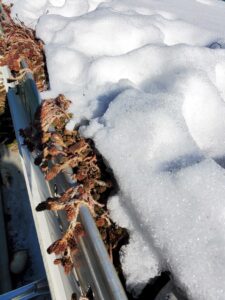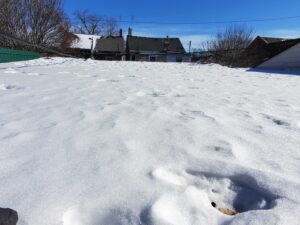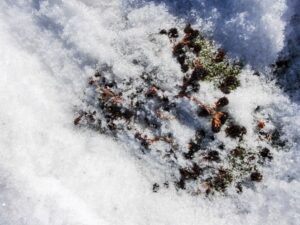My Green Roof & I Survived this Winter!
This blog is co-written by Cristina Senjug, Next Level’s communication manager along with Dr. Karen Liu, Next Level’s green roof specialist who was present when Cristina’s residential green roof was installed more than a decade ago.
Quietly thriving under a blanket of snow
As I work from my home office during the COVID-19 lockdown – stuck indoors in the city over the winter – I am ever grateful for small blessings such as our studio green roof to look upon. And, grateful for my wonderful colleagues, including Dr. Karen Liu who supervised its installation years ago.
Hardy, Resilient, Low Maintenance
Read Part 2 Winter Energy Savings
Nestled under a thick blanket of snow, our green roof in Toronto’s west end is now going on 12 years. The lightweight, “soilless” system was installed on a sloped roof (4:12). It is simple and loose laid consisting of four layers (root barrier, drainage, retention fleece and pre-vegetated sedum mat) and weighs less than 59 kg/m2. Perfect for our simple wood structure.
Sloped, sedum “carpet”
The vegetation, consists of sedum, and lies peacefully dormant. Sedum, or stonecrop is a resilient succulent with shallow roots that can withstand extreme climatic conditions. Many sedum species have alpine origins. Low growing, it forms a carpet cover and reproduces readily by seeds and cuttings. Sedum is not a fussy plant – it thrives despite of my minimal maintenance efforts. These qualities make sedum very popular on green roofs.
Adaptive to Cold Climates
Freezing can damage a plant’s living tissues just like frostbite. Sedum species are cold hardy due to evolutionary adaptation to their northern and alpine origins. They grow and reproduce quickly during spring and summer to take advantage of the warmer weather before going into dormancy in the winter.

Many species have also adopted small plant size in compact growth forms, thereby creating their own sheltered microclimate to protect themselves from the cold.
Most of the sedum species used on green roofs fall in plant hardiness zones 3-8 (with 0 being the coldest and 9 being the warmest), suitable for most urban centres in Canada.
Variety is the spice of life
There are about 400 species of sedum and they can be divided into deciduous, ever-green and semi-ever-green based on growth cycle. Sedum species with fine, small leaves tend to be more cold-hardy and less heat-tolerant than those with large, broad leaves, e.g., the small needle-like foliage of ever-green species of S. album and S. sexangulare would turn to a shade of copper red and shrink in size but do not drop in the winter. If you gently brush away the snow on my green roof, you will see their tiny leaves shimmer in the snow.

Our residential green roof on March 24, 2021 after the snow melted. The carpet of sedum plants are now ready to come out of dormancy.
On the other hand, the foliage of broad-leaf species such as S. kamtschaticum and S. ellacombianum would turn bright red in the fall like maple leaves and then drop off in the winter, shutting down the pathways that would normally carry water between roots and leaves as cold adaptation. Semi-ever-green species such as S. spurium would lose most of its leaves while keeping a small tight rosette at the tip of the stem. Therefore, a good mixture of sedum species is necessary to create winter visual interests on green roofs, especially in areas with little or no snow cover (e.g., Victoria, BC).
Snow cover protects the dormant plants on green roofs from convective heat transfer and desiccating effects of the cold winter wind. Snow offers good thermal insulation, like a blanket for the plants, protecting them from sudden temperature changes. It is not only unsafe to remove snow on the roof but can harm the plants.
As the sedum lays dormant under the blanket of snow, we ponder this green roof’s benefits and how winter affects energy saving and stormwater management? See part 2 Winter Energy Savings.




 NLSM has supplied more than 2.5 M SQFT coast to coast
NLSM has supplied more than 2.5 M SQFT coast to coast
Comments are closed.